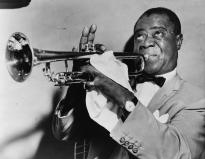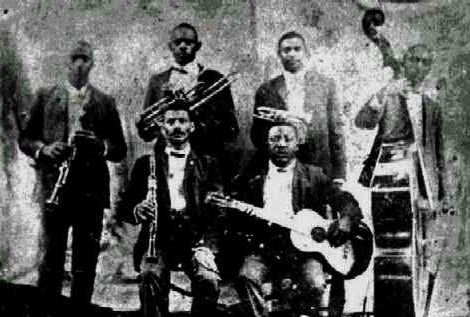New Orleans
and the History of Jazz

North American settlers needed a way to import and export goods via the Mississippi River, so a city was created atop swamps. By virtue of its location and its role in the international economy, New Orleans became home to a population that was as heterogeneous as any. Besides the French and, for a time, Spanish colonial powers, other groups included African Americans (both free and slave), people from the Caribbean and Latin America, and Scandinavians and other Europeans. The United States purchased Louisiana from France in 1803 (for $15M), and this more than doubled the size of the young country. The Louisiana Territory included parts of Alberta and Saskatchewan, as well as almost a quarter of the modern-day United States. Naturally, New Orleans became one of the country’s major cities. Its variegated racial realities played a major role in the spiritual and moral lives of Abraham Lincoln and Walt Whitman, both of whom first witnessed the true cruelties of slavery there. In his series of essays that eventually comprised the classic The Cotton Kingdom, Frederick Law Olmsted stated the following about New Orleans in the mid-1850s:
I doubt if there is a city in the world, where the resident population has been so divided in its origin, or where there is such a variety in the tastes, habits, manners, and moral codes of the citizens. Although this injures civic enterprise—which the peculiar situation of the city greatly demands to be directed to means of cleanliness, convenience, comfort, and health—it also gives a greater scope to the working of individual enterprise, taste, genius, and conscience; so that nowhere are the higher qualities of man—as displayed in generosity, hospitality, benevolence, and courage—better developed, or the lower qualities, likening him to a beast, less interfered with, by law or the action of public opinion.[1]
In the eighteenth and nineteenth centuries, the Crescent City, as it was known (due to the curvature of the Mississippi River as it surrounds the city), was alive with music. Music served as a psychological shield against the floods, fires, epidemics, and riots that marked New Orleans history, for it provided an excuse to forget, or a spur to overcome, the problems brought on by both nature and society. The most original form of that music, jazz, has come to be synonymous with New Orleans.
In the nineteenth century, balls or public dances were held in many American cities, and those in New Orleans were legendary—both for their popularity and their interracial audiences. To attract the maximum number of people to the dance floor, the bands of nineteenth-century New Orleans gradually mixed and matched musical styles, sowing the seeds of jazz. No musical genre was more popular than opera, and the arias that could be heard throughout the city day in and day out had a profound impact on the melodic styles of the musicians who created the jazz idiom, most notably the pianist/composer Jelly Roll Morton, reedman Sidney Bechet, and trumpeter/vocalist Louis Armstrong. Their precursors included the Creole composer Louis Moreau Gottschalk who, as far back as the mid-nineteenth century, wrote such works as “The Banjo” and “Bamboula,” which combined African and European idioms in a fresh and daring manner.
But if there is one specific place where the roots of jazz can be traced, it would be in Congo Square, where slaves were allowed to dance and generally express themselves. This is where the cultural mix that remains at the root of American (and subsequently, much of the world’s) popular music began. The slaves’ various forms of expression, rooted in Africa, intermingled with the New World. This outlet for the myriad emotions engendered by racism and slavery (as well as the hard-to-find and hard-won joys of life in such situations) started a stream of music that led to Buddy Bolden.

By all accounts, this barber/cornetist was the first musician whose music could be called jazz. It was the early twentieth century, and Bolden took ragtime, the music of day, and played it in a rough-and-ready style with the vocal and improvisatory feeling of the blues. Ragtime was conceived as a delicate, non-improvisatory style of piano music. Bolden’s transmogrification of it into a harder-edged improvisatory, horn-based form laid the groundwork for jazz bands of the future. His pioneering efforts inspired the next generation of musicians, including cornetist Joe “King” Oliver, who refined the approach into something far more sophisticated. At the root of the mature New Orleans style that Oliver and his band championed was a polyphonic approach to ensemble playing. This means that the horn players (two trumpets, clarinet, and trombone) all played concurrently. To do this without sounding jumbled called for each musician to listen intently to the others while simultaneously creating their own responses. One way to listen to classic New Orleans jazz at its best is to imagine the complexity of the melodies as a representation of its polyglot communities. It’s worth noting that at the very time that Bolden’s band was at its peak, the injustices of Plessy v. Fergusonwere making themselves manifest in the Crescent City and across the country.
Much has been made of the synergy between New Orleans’s fabled red-light district, Storyville, and the evolution of jazz. And while it’s true that the tremendous amount of vice that flourished there created around-the-clock work for musicians, the fact is that the majority of them worked elsewhere, and certainly not in the houses of ill-repute, which were mostly the exclusive province of pianists. Where Storyville does enter significantly into the picture is when it was closed in 1917 (purportedly too many servicemen on their way to fight World War I never returned after finding their way there on leave) and its population of entertainment-related workers had to look to other cities for employment. This coincided with the general migration northward of southern blacks, and within a few years many of the major players were relocating in Chicago (and more than few in California). This left the gap that the young Louis Armstrong filled (he was born in 1901, just a year too early to be drafted) and within a few years he rose to the top, eventually joining his mentor Oliver in Chicago in late 1922.
Armstrong’s travels took him to Chicago and then to New York. Jazz continued to survive in varying degrees in New Orleans as the music spread around the world, and by the 1940s the Crescent City became a Mecca for jazz lovers. There also continued to be a steady stream of first-rate jazz musicians who came from New Orleans and participated in all the current streams of music that were developing in Kansas City, Los Angeles, and New York. A short list would include tenor saxophonist Lester Young, who came to fame with Count Basie’s band, Ornette Coleman’s drummer Ed Blackwell, and in more recent years, the trumpeter/composer Wynton Marsalis. Of course, in terms of R&B and its offshoots, we only have to mention the names Fats Domino, Harry Connick, Dr. John, Professor Longhair, and Aaron Neville to be reminded of how New Orleans has stayed close to the core of popular music to this day.
It was a tragedy that brought New Orleans back to the world’s attention in the summer of 2005 when Hurricane Katrina not only ripped the city and its environs apart, but also exposed the racial and cultural dysfunctions that still exist in the United States. The city that never should have been there gave the world a tremendous cultural gift, jazz, whose progeny, popular music, was ultimately employed in fundraisers around the world to try to save New Orleans. Students and teachers alike will gain a new understanding of our nation’s past by looking into the untold strands of world history that are inextricably bound to the Crescent City.
[1] Frederick Law Olmsted, The Cotton Kingdom: A Traveller’s Observations on Cotton and Slavery in the American Slave States, 2nd ed. (New York: Mason Brothers and London: Sampson Low, Son & Co., 1862), 1: 302.
Loren Schoenberg is the executive director of the National Jazz Museum in Harlem and on the jazz faculty at The Juilliard School. A saxophonist who has worked with Benny Goodman, Bobby Short, and other jazz greats, he is the author of The NPR Curious Listener’s Guide to Jazz (2002) and myriad articles and essays as well as album notes, for which he has received two Grammys.